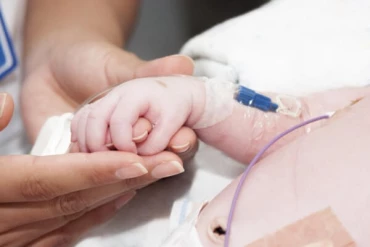Why Did Doctors Use Brain Cooling On My Baby?

There is a technique that is used on newborn babies when some kind of birth trauma occurs and there are indications that a brain injury occurred. The technique is called brain cooling and it consists of a water cooled blanket or cap being placed on a newborn baby to lower its body temperature by a few degrees.
This process is known as therapeutic hypothermia and it is typically done for three days after birth. Brain injuries in newborns can be caused when the baby’s brain doesn’t receive enough oxygen before, during, or shortly after birth. There are many different conditions and situations that can cause a lack of oxygen, some of which may be considered medical malpractice.
What Is Hypoxic Ischemic Encephalopathy?
Hypoxic ischemic encephalopathy, or HIE for short, is a type of brain damage that occurs due to an insufficient amount of oxygen reaching the brain (hypoxia), as well as a reduced blood flow to other vital organs (ischemia). Encephalopathy is used to describe any condition that is caused by a reduced oxygen and blood supply to the brain.
HIE can cause a wide range of medical conditions, some that are medically debilitating to the child and emotionally and financially debilitating to the child’s family. This can be further complicated because sometimes the severity of the child’s condition isn’t evident right away. In fact, it may take several years before all symptoms are instantly obvious.
What Are The Effects Of HIE?
It’s estimated that HIE occurs in .3 percent of all full-term deliveries. According to an article in the Journal of Biomedicine and Biotechnology, as many as 20 percent of those newborns die. Another 25 percent develop neurological conditions including learning disabilities, mental development delays, movement development delays, seizures, epilepsy, speech delays or problems, and cerebral palsy. The remaining newborns with HIE completely recover with no lasting effects.
You can see that there is a wide range of effects that vary from baby to baby. Traumatic birth experiences that may seem similar in two babies may result in a permanent, lifelong injury to one, while the other is completely spared. It hasn’t yet been determined why this happens.
Signs That Brain Cooling May Be Needed
While doctors do everything they can to ensure that newborns are as healthy as they can be, there are some signs that may indicate a baby might be at risk of oxygen loss that could be treated with brain cooling. These indicators include:
- Meconium in the amniotic fluid
- A challenging delivery
- Infant with heart abnormalities
- A delayed C-section
- Preeclampsia in the mother
- A baby to small or too large for gestational age
- Umbilical cord problems during birth
- Lack of oxygen in the mother’s blood prior to birth
- Premature birth
- Anemia in the newborn
Newborn Body Cooling Treatment For HIE
Newborns who have HIE benefit from brain cooling, or therapeutic hypothermia, promptly after birth. To treat a newborn, a cooling cap or blanket is placed on the baby and it lowers the baby’s temperature to about 91 degrees Fahrenheit. This temperature is maintained for the first three days following birth.
The lower body temperature slows the baby’s metabolic rate and decreases the release of endotoxins (caused by lack of oxygen) that are harmful. This allows the baby’s cells to recover over a longer period of time, which helps prevent further injury.
At the end of the three days, the baby is warmed back to a normal body temperature. For this type of treatment to be effective, it’s recommended that it be started within six hours of the birth. Babies who have HIE and are treated by the brain cooling technique have a higher chance of survival and a lower incidence of disabilities.
When Is Brain Cooling A Sign Of Medical Malpractice?
Medical errors can certainly cause HIE to occur. There are times that medical mistakes are made, diagnoses or treatment are delayed, or a medical professional is negligent, and it results in a HIE in a newborn. However, there are also times that HIE occurs and there is no medical malpractice to blame. Both situations may result in your baby receiving brain cooling treatment.
If your newborn had to be cooled after it was born, it’s important to know why as it could be a case of medical malpractice. Additionally, if your baby develops the cognitive or physical signs of HIE and he or she wasn’t treated with brain cooling, your doctor may also be found responsible. It’s important that you consult an experienced birth injury attorney to determine if your child’s condition is a case of malpractice.
Let The Birth Injury Lawyers At Ross Feller Casey Help You
At Ross Feller Casey, we have earned a national reputation for winning birth injury cases for our clients. Over the last five years, we have recovered more than $1 billion for clients and have won more major multimillion-dollar birth injury lawsuits than any other Pennsylvania firm.
Ross Feller Casey has highly experienced attorneys as well as a team of leading doctors right on staff to help litigate these types of lawsuits. All of our birth injury cases are handled on a contingency basis, which means you don’t pay unless we win.
Disclaimer: Ross Feller Casey, LLP provides legal advice only after an attorney-client relationship is formed. Our website is an introduction to the firm and does not create a relationship between our attorneys and clients. An attorney-client relationship is formed only after a written agreement is signed by the client and the firm. Because every case is unique, the description of awards and summary of cases successfully handled are not intended to imply or guarantee that same success in other cases. Ross Feller Casey, LLP represents catastrophically injured persons and their families in injury and wrongful death cases, providing legal representation in Pennsylvania and New Jersey.





